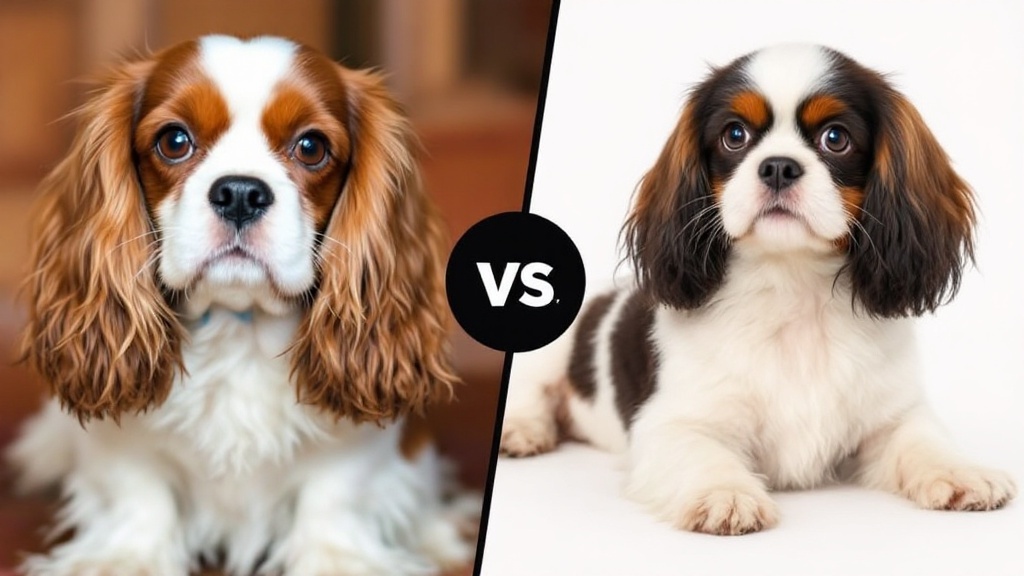Choosing between the Cavalier King Charles Spaniel and the Shih Tzu can be surprisingly tricky. Both breeds are small, sweet, and have a reputation for being great with families or apartment dwellers.
Their grooming needs, temperament, and energy levels are where you’ll notice the biggest differences.

If you’re thinking about one of these breeds, it helps to look at their traits side by side. The Cavalier King Charles Spaniel is gentle, affectionate, and playful.
Shih Tzus are loyal, calm, and sturdy, but their coat needs a lot more attention.
Breed Origins and History
Both breeds have deep roots with royalty and nobility. Their histories are quite different, but each one spent centuries as a favorite companion in their homeland.
Cavalier King Charles Spaniel History
The Cavalier King Charles Spaniel comes out of England, dating back to the 1600s. Small spaniels became popular with British royalty, especially King Charles I and II, and you’ll see them in paintings from that era.
By the 18th century, crossbreeding with Pugs changed their look. Later, breed enthusiasts worked to bring back the older, longer-nosed type, which led to the Cavalier we know today.
The Kennel Club officially recognized the breed in 1945.
Cavaliers are known for their gentle, affectionate nature. Their royal ties to England’s courts still shape their image.
Shih Tzu Heritage
Shih Tzus have ancient roots in China, going back over a thousand years. They were bred as companion dogs for Chinese royalty, especially during the Ming and Qing dynasties.
The name “Shih Tzu” means “lion dog” in Chinese, inspired by the lion statues guarding palaces.
These dogs lived in luxury and rarely left royal circles. For centuries, outsiders barely knew they existed, which is kind of wild to think about.
Shih Tzus are famous for their long, flowing coats and sweet personalities. Their regal background makes them one of the oldest toy breeds around.
Comparison to Other Toy Breeds
Both breeds are in the toy group, along with Maltese, Pugs, Bichon Frises, Yorkshire Terriers, Toy Poodles, Pomeranians, and Pekingese.
- Cavalier King Charles Spaniel: English origins, tied to British royalty.
- Shih Tzu: Chinese roots, connected to emperors and palaces.
Maltese and Bichon Frise came from the Mediterranean, while Pugs and Pekingese are also Chinese. Cavaliers and Shih Tzus stand out for their royal associations.
Toy Poodles and Yorkies were bred more for companionship and show, and Pomeranians, though popular with European nobility, originally came from much larger sled dogs.
Each toy breed has its own story, but Cavaliers and Shih Tzus are especially steeped in palace life.
Physical Characteristics
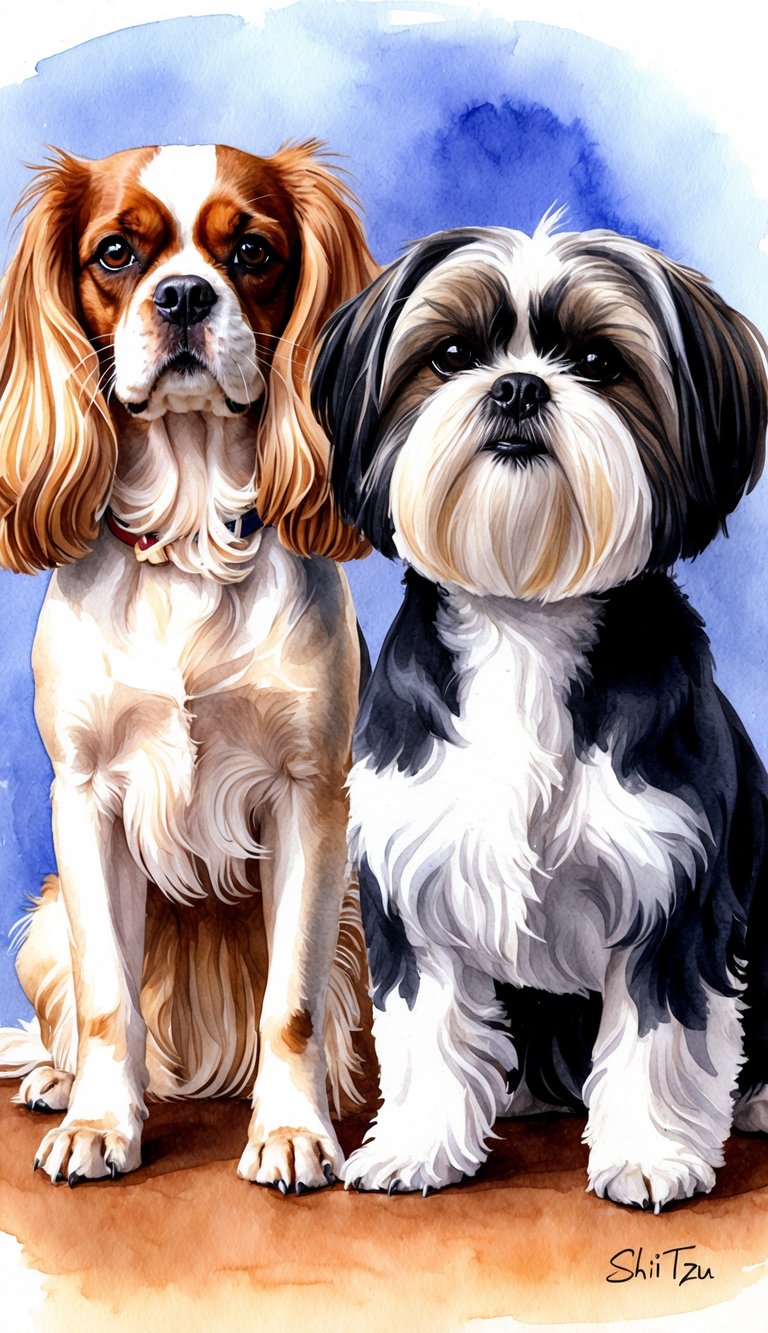
Both breeds are small, but their build and looks are pretty different. Each one has a distinct coat, body type, and color range.
Size and Build
Cavalier King Charles Spaniels are a bit bigger. They usually weigh 13–18 pounds (6–8 kg) and stand 12–13 inches (30–33 cm) tall at the shoulder.
Their frame is slim and graceful, with longer legs.
Shih Tzus are more compact, weighing 9–16 pounds (4–7 kg) and standing about 9–10.5 inches (23–27 cm) tall.
They have a stocky build, short neck, and broad chest.
Compared to breeds like the Chihuahua or Dachshund, Cavaliers and Shih Tzus are sturdier, but still smaller than a Beagle or Cocker Spaniel.
If you want a small dog that feels solid, the Shih Tzu is surprisingly hefty for its size, while Cavaliers are lighter on their feet.
Coat and Color Varieties
Cavalier King Charles Spaniels have silky, medium-length coats with feathering.
Their fur is soft and needs regular brushing, but not as much as a Poodle’s curls.
Common colors:
- Blenheim (chestnut and white)
- Tricolor (black, white, and tan)
- Ruby (solid red)
- Black & Tan
Shih Tzus sport a dense, long, double coat.
They barely shed, but daily brushing is a must to prevent tangles.
They come in almost any color or pattern—gold, white, liver, black, and plenty of mixes.
Their variety is a bit like French Bulldogs, which also have tons of color options.
Both breeds need regular grooming, but Shih Tzus require more.
A puppy cut can make things easier for Shih Tzu owners.
Typical Appearance Differences
Cavalier King Charles Spaniels have long, tapered snouts and big, round eyes for that gentle look.
Their ears are long and feathery, hanging close to the cheeks, and their bodies are sleek—think mini Cocker Spaniel.
Shih Tzus have flatter faces, short noses, and a noticeable underbite.
Their eyes are wide-set and round, with a rounded head and low-set, furry ears.
A Shih Tzu’s tail curls over its back, kind of like a Corgi or Basset Hound, but with its own style.
Cavaliers have long, tapered tails that stay level or slightly raised, but never curl tightly.
Once you know what to look for, you can spot the difference right away.
If you’re after a dog that looks gentle and alert, Cavaliers are classic.
Shih Tzus, meanwhile, stand out with their plush coat and bold face.
Temperament and Personality
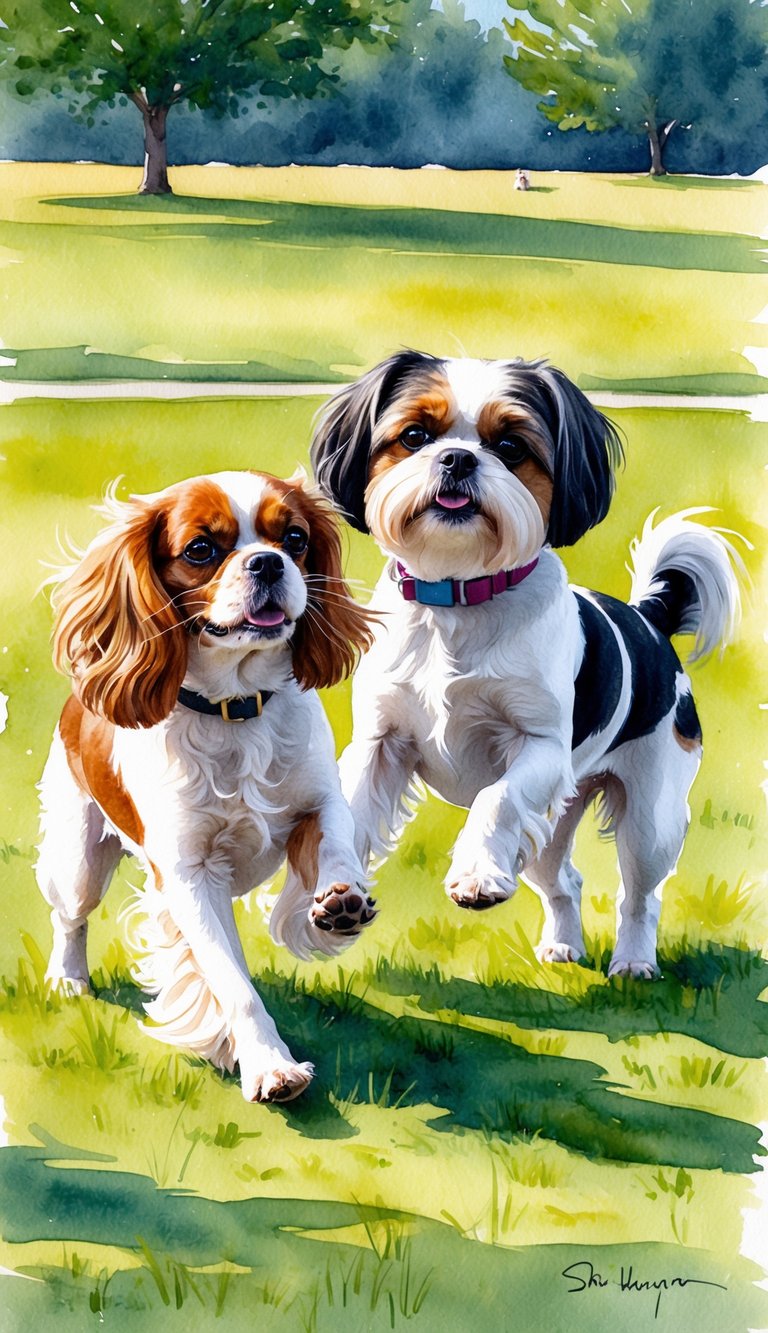
Cavalier King Charles Spaniels and Shih Tzus are both famous for being affectionate, friendly, and great companions.
They’re favorites for families and anyone craving a loyal, loving pet.
Affectionate Qualities
Cavaliers are incredibly affectionate and love being around people.
They’ll follow you from room to room, always hoping for a little attention or a cuddle.
Shih Tzus are loving, too, but they can be a bit more independent, especially with strangers.
They pour their affection into their favorite people and will greet you at the door or curl up in your lap when they’re in the mood.
Both breeds form strong bonds with their humans.
If you leave them alone too long, they can get anxious, so regular interaction is important.
| Trait | Cavalier King Charles Spaniel | Shih Tzu |
|---|---|---|
| Cuddle-prone | Very high | High |
| Patron loyalty | Strong | Strong |
| Attention needs | High | Medium-High |
Compatibility as Family Pets
Cavaliers are gentle and patient with kids.
They rarely snap, even during rough play, and they fit right into busy households.
Shih Tzus are friendly but may not love rough handling, especially from little kids.
They do best with gentle, respectful children and prefer quieter, calmer play.
Both breeds get along with other pets if you socialize them early.
Supervising play with small kids is always a good idea for everyone’s safety.
Suitability as Companion Dogs
Cavaliers are classic lap dogs.
They’re happiest when they’re with you—walking, relaxing, traveling, whatever.
Shih Tzus were bred to be royal lap dogs and still act like it.
They love close contact and are easy to bring along thanks to their size.
Both breeds pick up on your moods and enjoy short walks and indoor play.
If you want a dog who’s always nearby, either breed fits the bill.
Lap Dog Traits
Cavaliers are calm and love melting into your arms for long stretches.
They crave warmth and attention—maybe a little too much sometimes.
Shih Tzus love laps, too, but they’re a bit pickier about when and with whom they cuddle.
They’ll strut around proudly, sometimes choosing to sit beside you rather than on you.
Both breeds are small, gentle, and perfect for anyone wanting a cozy companion.
They’re well-suited to apartments or small homes, as long as you’re up for regular snuggles.
Exercise and Activity Needs
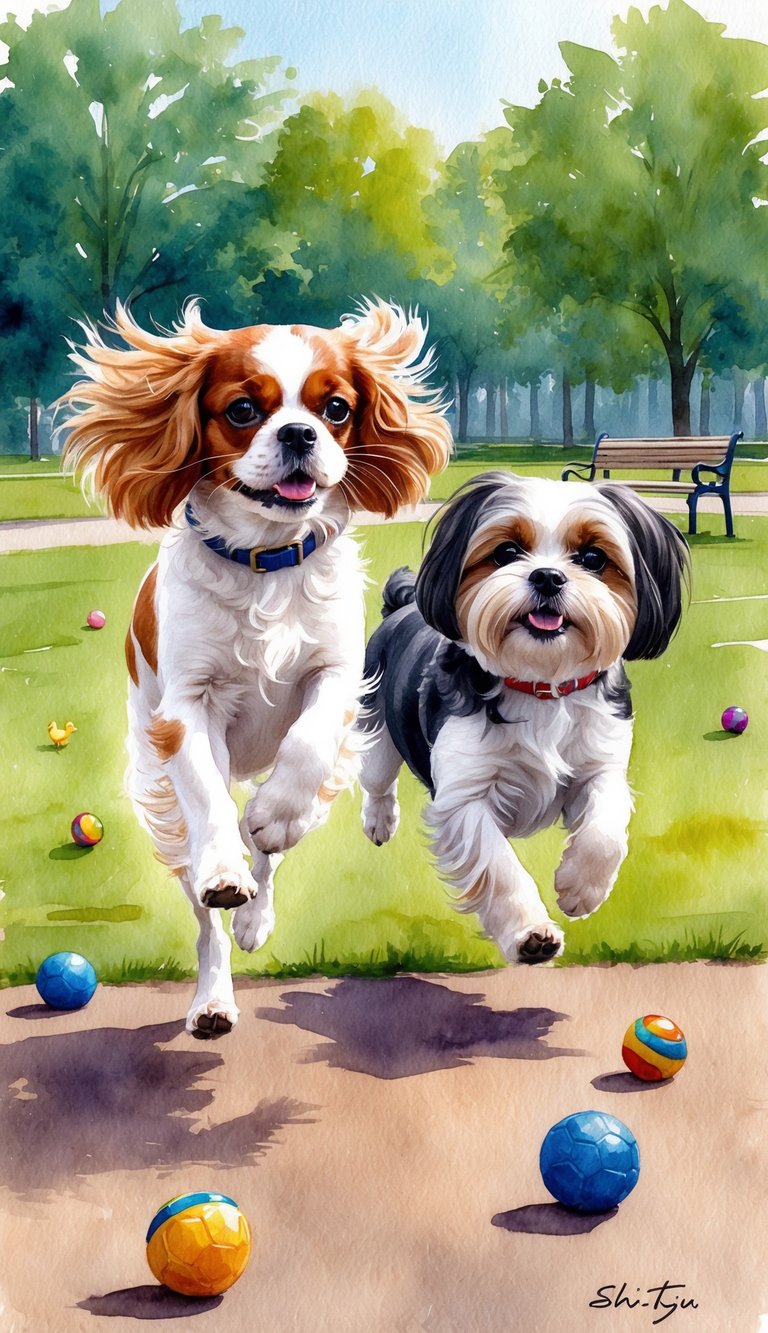
Both breeds need daily activity, but their exercise requirements aren’t identical.
It’s helpful to know what each one really needs.
Daily Exercise Requirements
Cavalier King Charles Spaniels usually need 30 to 60 minutes of exercise a day.
Walks, play in the yard, or a light jog all work.
They love games of fetch and need regular movement to avoid getting pudgy.
Shih Tzus have lower energy needs.
Most do fine with 20 to 30 minutes of walking or gentle play daily.
Because of their short noses, don’t overdo exercise—heat can hit them hard, and they tire out fast.
Short, broken-up sessions are best.
| Breed | Daily Exercise Need | Typical Activities |
|---|---|---|
| Cavalier King Charles Spaniel | 30–60 minutes | Walks, play, light jogs |
| Shih Tzu | 20–30 minutes | Short walks, gentle play |
Mental Stimulation
Both breeds get bored with the same old routine.
Mental stimulation is key to preventing bad habits and keeping them happy.
Cavaliers love learning simple tricks and playing with puzzle toys.
Short training sessions and games like hide-and-seek with treats keep them sharp.
Shih Tzus enjoy gentle training and interactive toys, though they can be a little stubborn.
Mix up their toys and use food puzzles to beat boredom and help them relax at home.
Training and Intelligence
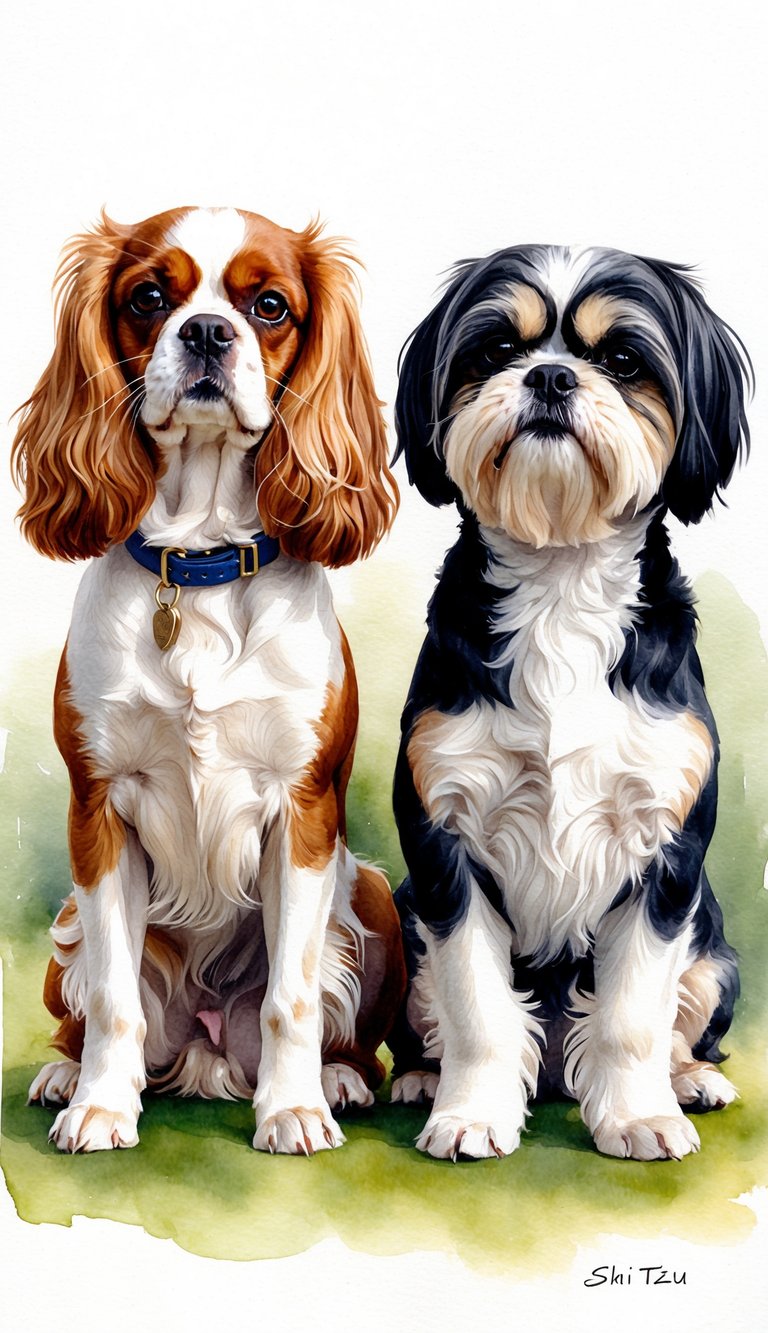
Cavalier King Charles Spaniels and Shih Tzus are both clever, but their smarts show up in different ways. How trainable they are and how they tackle problems can shape your daily routine with them.
Ease of Training
Cavaliers really want to please you and usually pick up tricks and commands pretty quickly. They seem to thrive when you use positive reinforcement, and their eagerness makes life easier for new dog owners.
Shih Tzus can be a little more, well, opinionated. They’re smart but might get bored or just decide not to listen sometimes. Training a Shih Tzu takes extra patience, especially for things like housebreaking.
Training Tips:
- Treats and praise go a long way for both breeds.
- Keep sessions short and upbeat, especially for Shih Tzus.
- Start socializing early so your dog grows up well-adjusted.
Problem Solving Skills
Cavaliers tend to look to their humans when they’re unsure. If they hit a puzzle, they’ll often check in with you for what to do next. They’re people-focused and love following your lead.
Shih Tzus? They’re a bit more independent. They’ll try different tactics to get what they want, which can be funny (and sometimes frustrating). Puzzle toys and games keep their brains busy and bring out their playful side.
Both breeds need mental stimulation. Mix up their routine with training games, interactive play, and some brain teasers to keep them sharp.
Health and Lifespan

Cavaliers and Shih Tzus each have their own health needs. Knowing what to watch for helps you keep them happy and healthy.
Common Health Issues
Cavaliers are prone to heart problems, especially mitral valve disease, which often shows up in middle age. They can also get syringomyelia, a painful brain and spine condition, plus some eye issues.
Shih Tzus often have trouble breathing because of their short snouts. They’re also at risk for eye problems, dental issues, and allergies. If you live somewhere hot, watch for overheating—they can’t handle heat well.
Regular vet visits, a healthy diet, and keeping an eye out for symptoms make a huge difference. Always choose breeders who screen for genetic problems.
Here’s a quick comparison table:
| Health Issue | Cavalier King Charles Spaniel | Shih Tzu |
|---|---|---|
| Heart Disease | Very common | Less common |
| Breathing Problems | Rare | Common |
| Eye Issues | Occasional | Often |
| Spinal Disorders | Syringomyelia is possible | Rare |
| Dental Problems | Moderate risk | High risk |
| Allergy Risk | Moderate | High |
Average Lifespan
Cavaliers usually live about 9 to 14 years. Heart disease can shorten their lives, so it’s smart to keep up with regular checkups.
Shih Tzus tend to live 10 to 16 years. Their biggest risks are breathing and dental issues, but with good care, they often reach their teens.
Your dog’s lifespan will depend on genetics, diet, and routine vet care. Keep them fit and catch problems early—simple, but it works. If you’re getting a puppy, ask breeders for health records; it matters more than people think.
Grooming and Care
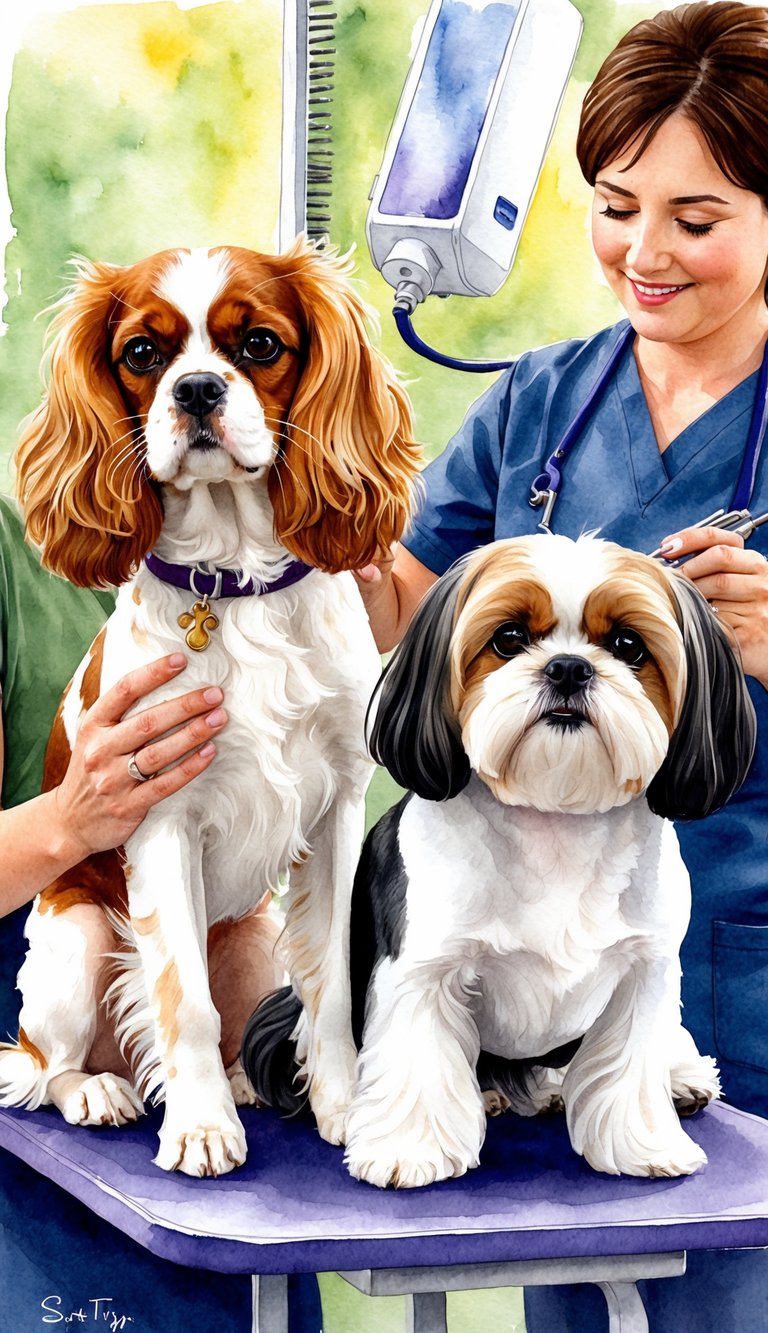
Cavaliers and Shih Tzus both need regular grooming, but their coats are very different. Brushing, bathing, and haircuts are part of the deal if you want to keep them looking and feeling good.
Shedding and Maintenance
Cavaliers have silky, medium-length fur that sheds all year. Usually, you’ll need to brush them three or four times a week to keep tangles and loose hair under control. During spring and fall, you might find yourself brushing even more.
Shih Tzus have long, dense hair that hardly sheds, but it tangles and mats super easily. Daily brushing is a must if you keep their hair long. With a “puppy cut,” every other day is probably fine. Both breeds pick up debris outside, so check their coats after walks.
Brushing Comparison Table
| Breed | Shedding Level | Brushing Frequency | Coat Type |
|---|---|---|---|
| Cavalier | Moderate | 3–4 times/week | Silky, medium-length |
| Shih Tzu | Low | Daily (long coat) or every other day (puppy cut) | Long and dense |
Professional Grooming Needs
Professional grooming needs aren’t the same for both breeds. Cavaliers don’t need haircuts but benefit from trims around their feet, ears, and sanitary spots every few months. Three or four groomer visits per year is usually enough.
Shih Tzus? They need regular haircuts, usually every 4–6 weeks, since their hair just keeps growing. Groomers can give them practical styles like the “puppy cut” to make home care manageable. Both breeds need nail trims, ear cleaning, and skin checks. Shih Tzus cost more to groom, mostly because their coats take more time and skill.
Living Conditions and Suitability
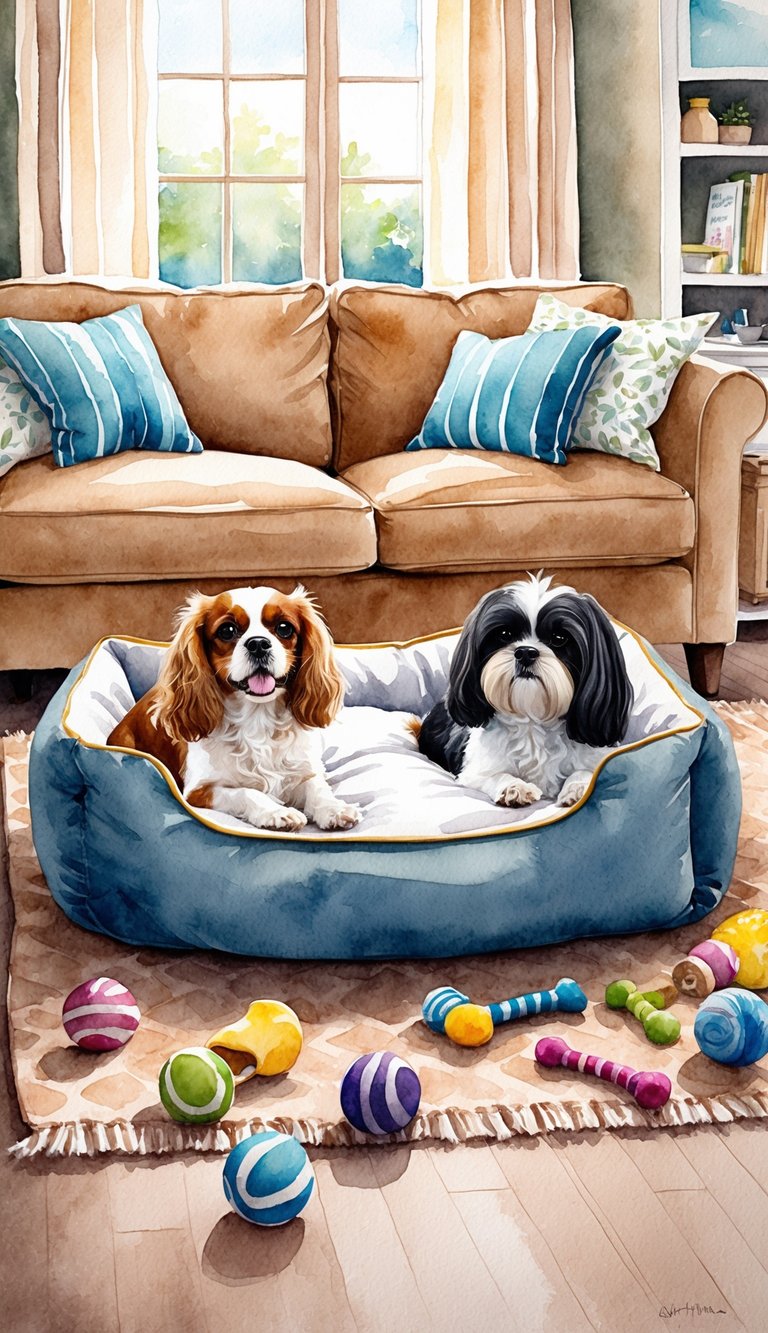
Cavalier King Charles Spaniels and Shih Tzus are both favorites for families, whether you have a big house or a cozy apartment. They’re adaptable and usually get along with all sorts of people and pets.
Adaptability to Home Environments
Cavaliers handle apartments or houses just fine. They love snuggling up in small spaces, as long as they get enough playtime and walks. Cavaliers are pretty quiet, so neighbors don’t usually complain.
Shih Tzus also fit well in apartments, condos, or bigger homes. They don’t need a yard but do appreciate short walks and indoor play. These dogs aren’t fazed by noise, so city life or a busy household won’t stress them out.
Comparison Table:
| Breed | Apartment Friendly | Adapts to Busy Homes | Low Exercise Needs |
|---|---|---|---|
| Cavalier | Yes | Yes | Moderate |
| Shih Tzu | Yes | Yes | Low |
Both breeds want to be near their people. Leaving them alone for long stretches isn’t a great idea.
Interaction with Children and Other Pets
Cavaliers are gentle with kids and usually super patient. They rarely snap and tend to get along with other dogs or cats, especially if they grow up together.
Shih Tzus are friendly too, but they do best with children who know how to treat small dogs. They like calm play and can get startled by roughhousing. Shih Tzus usually accept other pets, but early socialization helps avoid shyness or jealousy.
Key Points:
- Cavaliers are good with all ages and most pets, with supervision.
- Shih Tzus do best with gentle kids and generally get along with other animals.
Both breeds need social time and a little guidance, but their playful, loving attitudes make them great for families and homes with other pets.
Cost of Ownership
Owning a Cavalier or a Shih Tzu can definitely impact your wallet. It’s smart to know what you’ll spend up front and what to expect month to month.
Initial Costs
Cavalier King Charles Spaniel puppies usually run between $1,500 and $3,000 from a solid breeder. Shih Tzu puppies cost a bit less, typically $800 to $2,000. Prices swing depending on where you live, the breeder’s reputation, and the puppy’s pedigree.
You’ll also need basics like:
- Crate ($30–$80)
- Bed ($20–$50)
- Bowls ($10–$30)
- Toys ($20–$40)
- Collar and leash ($15–$30)
Vet checks, first shots, and microchipping usually add up to $100–$250 early on. Spay or neuter surgery is another $200–$500.
Ongoing Expenses
Monthly food costs hover around $20–$40. Treats, chews, and dental stuff can tack on another $10–$20.
Grooming is a big chunk:
- Shih Tzus need a pro groom every 4–6 weeks, at $50–$80 per visit.
- Cavaliers need less frequent trims, around $30–$60 each time, but you’ll still be brushing at home.
Yearly vet visits, shots, and flea/tick meds usually come to $300–$600. Emergency health costs can pop up, so it’s wise to have a buffer.
Budget for toys, beds, and replacements—maybe $50–$100 per year. Pet insurance is an option and typically costs $30–$50 a month.
Breed Popularity and Recognition
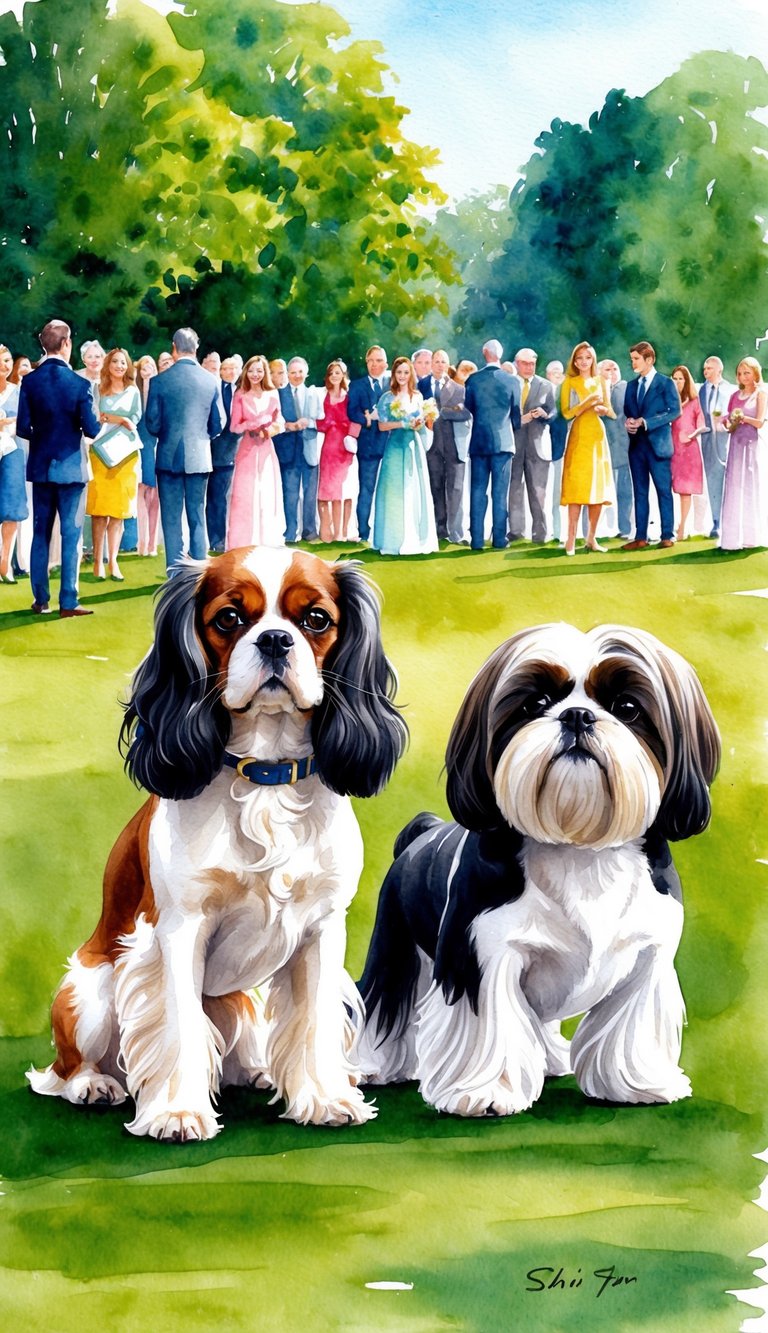
Cavalier King Charles Spaniels and Shih Tzus are both iconic toy breeds. Major kennel clubs recognize them, and their popularity has shifted over the years.
Kennel Club Standards
The American Kennel Club (AKC) and the United Kennel Club (UKC) both recognize these breeds.
The Cavalier King Charles Spaniel falls under the Toy Group. Judges look for expressive eyes, a feathered coat, and a super friendly vibe. The AKC says they should weigh between 13 and 18 pounds.
The Shih Tzu is also in the Toy Group. Standards focus on their sturdy body, short muzzle, and that lush double coat. The AKC’s ideal weight is 9 to 16 pounds.
Here’s a handy table for quick reference:
| Breed | AKC Group | Weight Range | Notable Features |
|---|---|---|---|
| Cavalier King Charles Spaniel | Toy | 13–18 pounds | Large eyes, silky coat |
| Shih Tzu | Toy | 9–16 pounds | Short muzzle, long coat |
For the latest details, check the AKC or UKC websites. They update breed info pretty regularly.
Trends Among Toy Breeds
Toy breeds like the Cavalier King Charles Spaniel and Shih Tzu have really taken off lately, especially in cities. Their small size and friendly personalities make them a good fit for apartments or families with kids.
According to AKC registration stats, the Cavalier King Charles Spaniel usually lands in the top 20 most popular dogs in the U.S. The Shih Tzu isn’t far behind, often making the top 30.
You’ll see both breeds all over social media and hanging out with celebrities, which definitely boosts their popularity. Some people pick Shih Tzus because they’re supposed to be hypoallergenic and super loyal.
Honestly, toy breeds are just kind of trendy right now. More folks want pets that are easy to handle and have big personalities packed into small bodies.
Privacy Considerations for Dog Owners
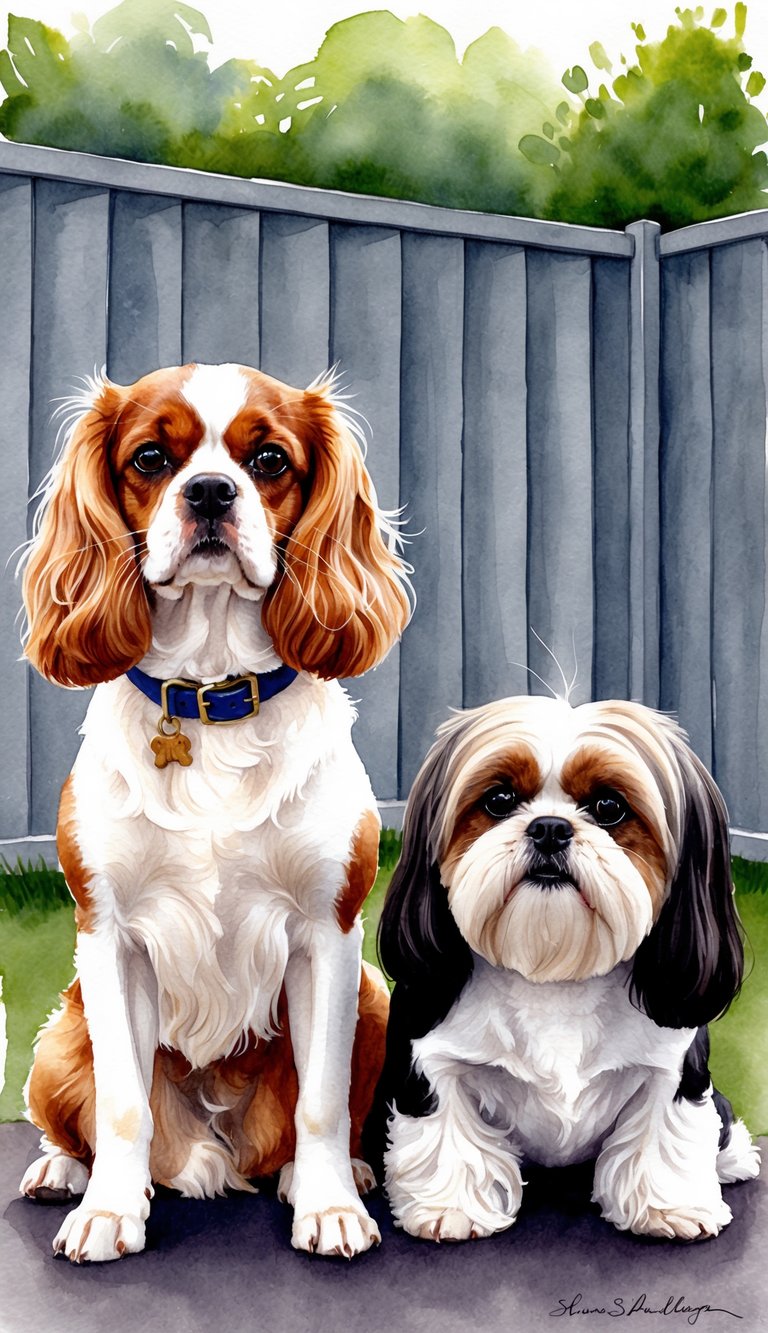
When you use online services related to your Cavalier King Charles Spaniel or Shih Tzu, companies usually track and store your data. It’s smart to care about privacy and know how cookies work when you’re browsing pet sites or shopping for dog stuff.
Personal Data in Dog Ownership
A lot of dog websites or online shops ask for your name, address, email, or phone number. They need this for things like making accounts, shipping dog food, or registering your pup for events.
Sites also collect your IP address to keep things secure, block spam, or check who’s logging in. Some use what you search for to show you products or services that match your dog’s breed.
If you join forums for Cavalier King Charles Spaniel or Shih Tzu owners, don’t overshare in public posts. It’s easy to forget how much you’re putting out there online.
Here’s a quick list of data sites usually collect:
- Name, address, and contact details
- Purchase and search history
- IP address and device info
- User account details
Always check privacy settings before you sign up anywhere. Make sure you actually trust the sites you’re using.
Cookie Policy and Consent
Most pet-related sites use cookies to remember your preferences and save login details. They also personalise advertising and track what you do on the site.
Before you start browsing, you’ll usually spot a cookie policy notice asking for your permission. It’s a bit annoying, but it gives you some control over your data.
You can tweak your cookie settings on most sites. This lets you decide what gets tracked, which is honestly pretty handy.
Some cookies are necessary for security, like keeping your account safe or blocking spam. Not all cookies are out to get you—some actually help.
Advertising partners, including companies like Yahoo, might use cookies for personalised ads about dog food or toys. It’s smart to read the cookie policy and adjust your consent so it fits your privacy comfort zone.
If you don’t give consent, you might lose access to a few website features. Still, you can usually browse most info without much hassle.



